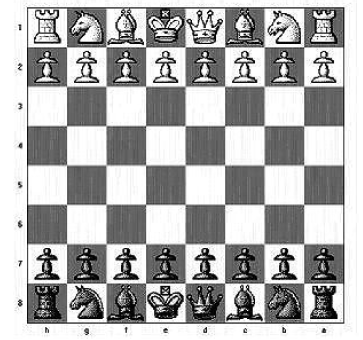注:全部习题来自POJ 项目,原题目要求使用 C/C++ 实现。
问题描述
国际象棋的棋盘是黑白相间的 8 * 8 的方格,棋子放在格子中间。如下图所示:

王、后、车、象的走子规则如下:
- 王:横、直、斜都可以走,但每步限走一格。
- 后:横、直、斜都可以走,每步格数不受限制。
- 车:横、竖均可以走,不能斜走,格数不限。
- 象:只能斜走,格数不限。
写一个程序,给定起始位置和目标位置,计算王、后、车、象从起始位置走到目标位置所需的最少步数。
输入数据{{3}}
第一行是测试数据的组数t(0 <= t <= 20)。以下每行是一组测试数据,每组包括棋盘上的两个位置,第一个是起始位置,第二个是目标位置。位置用”字母-数字”的形式表示,字母从”a”到”h”,数字从”1″到”8″。
输出要求
对输入的每组测试数据,输出王、后、车、象所需的最少步数。如果无法到达,就输出”Inf”.
输入样例
2
a1 c3
f5 f8
输出样例
2 1 2 1
3 1 1 Inf
代码1
#! usr/bin/perl
use strict;
use warnings;
use 5.010;
# my $my_test =("A"==0);
# print $my_test;
sub input_check {
my ($x1, $x2, $sp, $y1, $y2);
my @num_of_steps;
# devide input to get coordinates;
for (@_) {
$_ = uc($_); #Capitalized the string;
# a simple check if input is valid
if(length($_) != 6) {
($x1, $y1, $x2, $y2) = (0,0,0,0);
} # This exception would be treated later.
else {
($x1, $y1, $sp, $x2, $y2) = split //, $_;
}
my $same_point; {{4}}
if (($x1 eq $x2) && ($y1 == $y2)){
$same_point = 1;
}
else {
$same_point = 0;
}
# check if points are in the same straight line
my $same_stra_line;
if (($x1 eq $x2) || ($y1 == $y2)){
$same_stra_line = 1;
}
else {
$same_stra_line = 0;
}
# check if points are in the same skew line
my $same_skew_line;
if ((ord($x1)-ord($x2)) == ($y1-$y2)){
$same_skew_line = 1;
}
else {
$same_skew_line = 0;
}
# check if points are in the same while/black zone
my $same_zone;
# $same_skew_line = (((ord($x1)%2) xor ($y1%2)) == ((ord($x2)%2) xor ($y2%2)));
if (((ord($x1)%2) xor ($y1%2)) == ((ord($x2)%2) xor ($y2%2))){
$same_zone = 1;
}
else {
$same_zone = 0;
}
# calculate the max distance
my $max_dist;
$max_dist = (abs(ord($x1)-ord($x2)))>= (abs($y1-$y2))? abs(ord($x1)-ord($x2)):abs($y1-$y2);
if($x1 eq "0"){
push @num_of_steps, "invalid input\n";
}
elsif($same_point) {
push @num_of_steps, join(" ",0,0,0,0)."\n";
}
else {
push @num_of_steps, join(" ", $max_dist, ($same_stra_line || $same_skew_line)?1:2, $same_stra_line?1:2, ($same_zone?($same_skew_line?1:2):"Inf")."\n");
# push @num_of_steps, $max_dist." ".$same_stra_line." ".$same_skew_line." ".$same_zone;
}
}
@num_of_steps;
}
my @coor_input;
# my @coor_output;
print "Please input a number of coordinates!\n";
@coor_input = (<STDIN>);
print &input_check(@coor_input);
# print "@coor_output\n";
[[3]] Again,这里略去了输入测试数据组数的要求。[[3]]
[[4]] 这里有一个奇怪的问题。执行这两行会得到一个警告和输出 1。在使用 == 和 eq 进行比较时,应特别谨慎。[[4]]